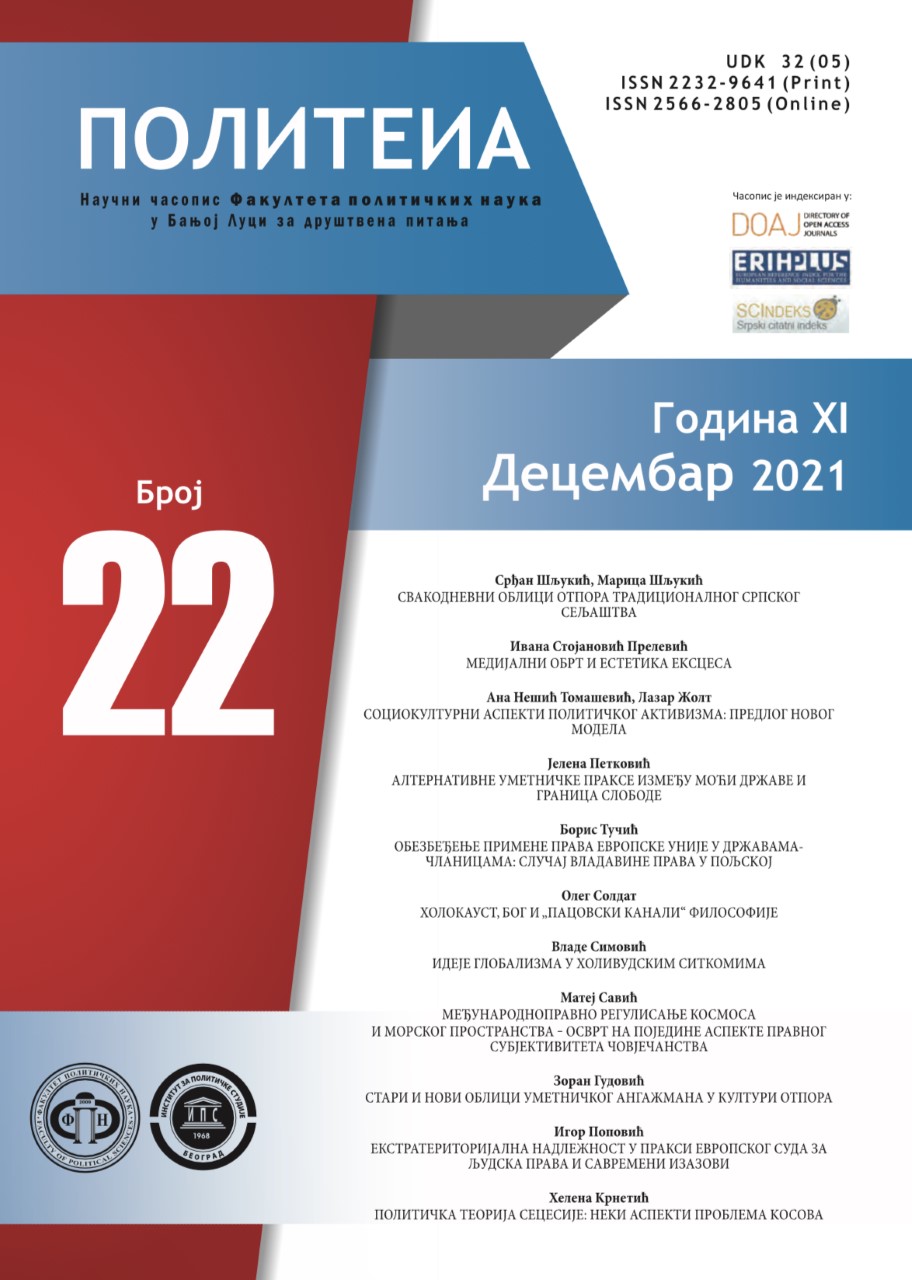MEDIJALNI OBRT I ESTETIKA EKSCESA
Sažetak
Evolucija medijskog sistema uticala je na ljudske oblike komuniciranja i odnos čoveka prema stvarnosti (Schmidt, 2013). Takođe, promenio se odnos medija prema čoveku. Čovek postaje sredstvo, a ne cilj medija, što je suprotno stanovištu deontološke etike koja se, između ostalog, temelji na poštovanju čovekovog dostojanstva. Nakon prelaska sa komunikativnosti na medijalnost, govori se o medijatizaciji uma (razvoj kompjutera) i o tehnocentrizmu (Krämer, 1989). Medijalni obrt podrazumeva da je forma značajnija od sadržaja, što se naročito primećuje u estetici medija, koju nakon medijalnog obrta možemo nazvati estetikom ekscesa (Lipovecki, Seroa, 2013).
U radu je objašnjen fenomen medijalnog obrta i estetika medija karakteristična za taj period. Korišćena je deskriptivna metoda. S obzirom na to da je vizuelna kultura široko rasprostranjena, upravo zahvaljujući razvoju tehnologije i upotrebi različitih efekata, fokus medijskih sadržaja sve je više na slici, što odgovara hipotezi prema kojoj je savremeno društvo ‒ društvo slike a ne teksta (Mirzoef, 1983). Ovo je ujedno i glavna hipoteza rada, koja u zaključku biva potvrđena.
Reference
Anakijev, S. (2012). Instrumentalizacija senzacionalizma ‒ tabloidi. Stetoskop. Posećeno:3. 9. 2021. URL:https://www.stetoskop.info/psihologija-danas/instrumentalizacija-senzacionalizma--tabloidi
Bruhn, J. (2016). What is Mediality and How does it matter? Theoretical Terms and Methodology, doi: 10.1057/978-1-137-57841-9_2
Burdije, P. (2020). Narcisovo ogledalo, Beograd: Clio.
Catwright, L. Sturken, M. (2001). Practice of Looking, An Introduction to Visual Culture, New York: Oxford University Press.
Colapietro, V. (2006). Democracy as Moral Ideal, The Kettering Review, 24:3, 21‒31.
Derida, Ž. (1976). O gramatologiji, Sarajevo: Veselin Masleša.
Foster, H. (1988). Vision and Visuality. Seattle, WA: Bay Press.
Galtung, J., Holmboe Ruge, M. (1965). The Structure of Foreign News. The Presentation of the Congo, Cuba and Cyprus Crises in Four Norwegian Newspapers, Journal of Peace Research. 2 (1): 64–91.
Guillory, J. (2010). Genesis of the Media Concept. Critical Inquiry 36, Posećeno: 1. 8. 2021. URL: http://www.journals.uchicago.edu/t-and-c.
Gonzalo, H. F. (2012). Filozofija zombija, Beograd: Geopolitika.
Hajdeger, M (1999). Pitanje o tehnici, Predavanja i rasprave, Beograd: Plato.
Hartmann, F. (2008). Kommunikation als “Ideologie”, B. Mersmann, Th. Weber (Hrsg.), Avinus Verlag: Berlin, p. 89‒90.
Hudzik, J. (2018). From Hegel to Zielinski: An Essay from German Media Philosophy, Flusser Studies. 25, 1‒28.
Krämer, S. (1989). Das Medium als Spur und als Apparat, ed. Krämer, S. Medien, Computer, Realitet Wirklickeitvostellungen und Neue Medien, , Frankfurt, a. M. : Suhrkamp, 73‒94.
Kostanić, M. (2015). Jesu li mediji u kapitalizmu nužno kapitalistički? Mašina, Posećeno: 3. 9. 2021. URL: https://masina.rs/jesu-li-mediji-u-kapitalizmu-nuzno-kapitalisticki/
Lipovecki, Ž. (1987). Doba praznine: ogledi o savremenom individualizmu, Beograd: Knjižarnica Zorana Stojanovića.
Lipovecki, Ž., Seroa, Ž. (2013). Globalni ekran: od filma do smartfona. Beograd: Akademska knjiga.
Manović, L. (2001). Metamediji, Beograd: Centar za savremena medijska istraživanja.
Mirzoeff, N. (1983). Visual Culture: An Introduction. Posećeno: 1. 8. 2021. URL: https://cl4englishlistening.files.wordpress.com/2014/04/doc-21-mirzoeff-what-is-visual-culture.pdf
Mitchell J.W.T., Hansen, M.B.N (2010). ed. Critical Terms for Media Studies, USA: University Chicago Press.
Ralston, S. (2016). The Turn Within the Pragmatic Turn: Recovering Bernstain’s Democratic Dewey. Richards Bernstain and the Pragmatist Turn in Contemporary Philosophy, Rekinding Pragmatism’s Fire. 98-110. Posećeno: 27. 7. 2021. URL: https://www.researchgate.net/publication/304861200 doi: 10.1057/9781137352705_7
Ostin, Dž.L. (1994). Kako delovati rečima? Novi Sad: Matica srpska.
Rivero, J.J.B. (2019). „Mediality, Temporality, Social Cognition and Evolution“, Philosophies.
Sandbothe, M. (2005). Pragmatic Media Philosophy. The Basis of New Discipline in The Era of Internet. Online Publication: www.sandbothe.net.
Schmidt, S. J. (2013). Media Philosophy: A Reasonablee Program? Munster.
Stepanov, M. (2013). „What is Pragmatic Media Philosophy?“ Pragmatism Today, Vol 4, Issue 1, 85‒93.
Stojanović Prelević, I. (2020). Filozofija medija ‒ pragmatički i aksiološki aspekti medija, Niš: Filozofski fakultet.
Todorović L. (2017). Diskurs novih tehnologija Beograd: Clio.
Вујаклија, М. (1980). Лексикон страних речи и израза, Београд: Просвета (Vujaklija, M. (1980) Leksikon stranih reči i izraza, Beograd: Prosveta).
Vukadinović, M. (2013). Zvezde supermarket kulture.
Autori koji objavljuju u ovom časopisu pristaju na sljedeće uslove:
- Autori zadržavaju autorska prava i pružaju časopisu pravo prvog objavljivanja rada i licenciraju ga "Creative Commons Attribution licencom" koja omogućava drugima da dijele rad, uz uslov navođenja autorstva i izvornog objavljivanja u ovom časopisu.
- Autori mogu izraditi zasebne, ugovorne aranžmane za neekskluzivnu distribuciju članka objavljenog u časopisu (npr. postavljanje u institucionalni repozitorijum ili objavljivanje u knjizi), uz navođenje da je članak izvorno objavljen u ovom časopisu.
- Autorima je dozvoljeno i podstiču se da postave objavljeni članak onlajn (npr. u institucionalni repozitorijum ili na svoju internet stranicu) prije ili tokom postupka prijave rukopisa, s obzirom da takav postupak može voditi produktivnoj razmjeni ideja i ranijoj i većoj citiranosti objavljenog članka (Vidi Efekti otvorenog pristupa).

